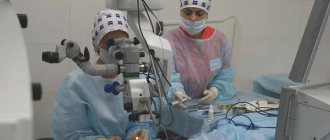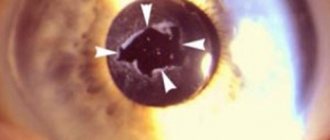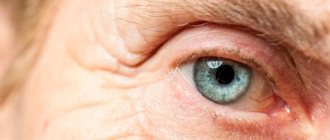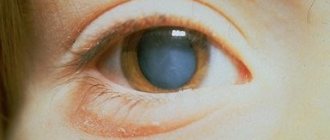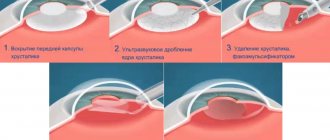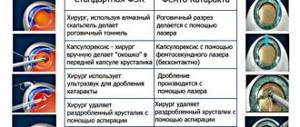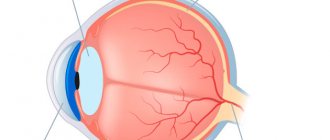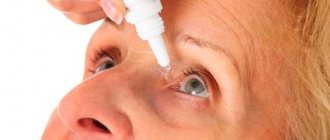The answer to this question is quite simple. In fact, lens surgery is associated with the need to improve or restore a person’s vision; usually, lens replacement is associated with the treatment of cataracts, so a postoperative manifestation such as a decrease in vital capabilities is most likely a sign of a newly formed problem.
Its occurrence can be justified by the occurrence of complications due to the incorrect course of the surgical intervention or violations that occurred during the recovery period.
It must be remembered that vision returns gradually after lens replacement, that is, within 4-5 weeks. Therefore, expecting an immediate effect after a few days is simply unreasonable. It will take patience, and after some waiting you will be able to fully communicate with the world around you again.
Possible postoperative complications
Indications for eye lens replacement are always individual. That is why before starting treatment it is necessary to visit not only an ophthalmologist. In addition to him, you will also have to undergo specialists with a more narrow focus, for example, an endocrinologist. This is necessary for those patients who suffer from diabetes or other pathologies of the endocrine system, which can become a serious obstacle to the operation. The selection of a lens, or, as ophthalmologists call it, an intraocular lens, is also carried out individually for each person.
It is this scrupulousness that allows you to achieve high results of laser correction. However, despite this, some patients experience complications after having their lens damaged by cataracts replaced. The postoperative period for them may be longer and more difficult than for most other patients. The main types of complications are:
- infectious inflammation, the risk of which is quite low if the operation was performed in a clinic using modern equipment, but it still cannot be excluded from the list of possible complications;
- clouding of the lens capsule, which occurs due to the proliferation of epithelial tissue cells. As a result, the patient sees even worse than before the operation;
- swelling of the cornea caused by the insertion of surgical instruments into the eyeball. Usually the swelling goes away within a day. If it does not go away within this time, you need to seek help from a doctor;
- hemorrhage is a complication that occurs quite rarely and only if we are talking about cataracts formed after an eye injury;
- loss of the ability to clearly distinguish visible objects located at different distances from the eyes;
- increased intraocular pressure due to the use of solutions during vision correction.
We have listed the main types of complications that are possible after replacing the eye lens with an artificial one. However, if the patient suffered from chronic diseases, the list may be expanded.
Do's and Don'ts after cataract surgery
Restrictions after cataract surgery - the doctor gives recommendations to patients individually, both verbally and in writing. Following the recommendations helps restore vision and avoid complications.
Restrictions apply:
- visual stress;
- sleep patterns;
- hygiene;
- physical activity;
- lifting weights;
- thermal procedures;
- use of decorative cosmetics;
- nutrition and fluid intake;
- drinking alcohol and smoking.
It is advisable to avoid intense visual stress for the entire rehabilitation period. Watching TV and working on the computer should be limited to 15 minutes. You can read in good lighting and only if there is no eye discomfort.
Stop driving a car for a month.
Restrictions on sleep patterns mainly concern posture. You should not sleep on your stomach, on the side of the operated eye. Follow the recommendations for at least a month after the intervention. The duration of sleep affects vision recovery. In the first days, it is recommended to sleep at least 8 hours a day.
Hygiene restrictions help prevent water, cosmetics, and foreign particles from entering the operated eye. In the first days, you need to wash your face carefully, without using soap or gel. It is best to gently wipe your face with a damp pad.
To prevent the entry of foreign particles, it is recommended to wear a two-layer gauze bandage that tightly secures the eye when closed. You should not stay in dusty, smoky rooms for a long time.
Physical activity can provoke an increase in intraocular pressure, displacement of the intraocular lens, and hemorrhages. Intense, sudden movements should be avoided for a month after the intervention. Some sports are permanently contraindicated after cataract extraction - cycling, diving, horseback riding.
Lifting heavy objects in the postoperative period is contraindicated. The first month the maximum weight of the load is 3 kilograms. Later it will be possible to lift up to 5 kilograms.
Heat treatments can promote hemorrhages. For at least a month, the patient is advised to refrain from visiting a bathhouse, sauna, exposure to the open scorching sun, or washing his hair with hot water.
Decorative cosmetics cannot be applied to the face for 5 weeks after surgery. Then you can use it with caution.
For several weeks, the diet is limited to spices, salt, and animal fats. To combat swelling, reduce fluid intake in the first days after treatment.
It is recommended to avoid drinking alcohol and smoking for a month. An important point is the fight against passive smoking.
To monitor vision recovery in the postoperative period, the patient must undergo regular examinations by an ophthalmologist. For the first month, such visits are weekly. Further consultations are carried out according to an individual schedule.
Completion of the operation and the first days after it
Immediately after removal of the lens of the affected eye, the patient’s visual organs are covered with a special bandage, which is necessary to protect the operated eye from various contaminants, such as dust. As a rule, the next day, it is removed. After this, you need to wipe your eyelids with a special cotton swab soaked in a solution of 0.02% furatsilin or a solution of 0.25% chloramphenicol. In most modern clinics, this procedure is carried out by qualified specialists, but after surgery in a municipal hospital, you will most likely have to remove the bandage yourself. On the first day after surgery, you should not constantly wear a bandage. It must be worn if the patient decides to go outside, especially if the weather is windy or rainy. The main rule is to use a new, sterile dressing every time. Indoors, during rehabilitation after replacing the lens, it can be replaced with a homemade “curtain”, which you can easily make yourself, for example, using gauze.
Again, it is very important that the gauze used is sterile, ideally freshly purchased from a pharmacy. There are many videos on the Internet that show in detail how to make such a “curtain” bandage. It is attached to the forehead using a medical plaster. This does not prevent the eyes from moving in any way and allows them to fully “breathe.” In the first days of the postoperative (recovery) period, pain may occur in the temporal lobes, as well as in the eyebrow area. In such cases, ophthalmologists recommend taking one of the non-steroidal painkillers available in your home medicine cabinet. If the pain does not go away within a week, you should seek help from a doctor.
How are cataracts treated?
In modern laser surgery, the only reliable way to restore vision in case of cataracts is to replace the clouded lens with a new, so-called IOL - an artificial intraocular lens, or artificial lens, with parameters as close as possible to the natural organ. This operation is called “phacoemulsification” and is done using a femtosecond laser. The operation takes only 10-15 minutes.
A small incision of 1.8 mm is made in the cornea, then the lens is softened by ultrasound and turned into an emulsion. Then the front part of the lens capsule is removed. The lens is inserted into the eye in a folded state, unfolds independently inside and is securely fixed. In this case, no stitches are even required, and the patient’s vision returns in the operating room.
Using eye drops during rehabilitation
It is important to understand that rehabilitation after replacing the lens of the eye for cataracts requires a mandatory visit to an ophthalmologist. As a rule, the use of special eye drops plays an important role during this period. When used correctly, they can reduce recovery after surgery and protect the eyes from various types of infections. In most cases, the matter is not limited to prescribing one type of drops. Depending on individual indications, the patient may be prescribed:
- disinfectant drops, for example: “Okomistin”, “Albucid”, “Tobramitsin”;
- anti-inflammatory drops, for example: “Dexamethasone”, “Indocollir”, “Diclo-F”;
- combined drops, for example: Thiotriazolin, Dexona, Neladex.
After removing the affected lens with a laser, ophthalmologists prescribe the above drops to be used according to the so-called “decrease scheme”. During the first week, they must be instilled into the eyes four times: in the morning, after waking up, at lunch, before or after dinner (depending on the instructions for the drug) and before bed. During the second week, the fourth dose per day is canceled, that is, the drops are used only three times.
During the third week - two, during the fourth - only one. However, these are the most common treatments during the postoperative period. In each specific case, the plan can be adjusted by an ophthalmologist.
Using eye drops after cataract removal
In the standard case, after cataracts, patients are prescribed three types of medications - eye drops and gels:
- Antibacterial drops in combination with dexamethasone in one bottle. This is to prevent infection and relieve postoperative inflammation. The eye gradually calms down, redness and swelling of the tissues go away.
- Non-steroidal anti-inflammatory drugs. The drops have an analgesic effect. Their administration to patients with diabetes mellitus is especially important, since the risk of macular edema after surgery is reduced.
- A gel that accelerates the healing of the cornea or moisturizing drops provide relief and comfort. Discomfort after surgery, the feeling of a foreign body in the eye gradually disappears.
All medications are prescribed only by the attending physician. The course of postoperative treatment takes a month, but each medication has its own strict regimen. In more complex cases or if the patient has concomitant eye diseases, the specialist prescribes additional medications.
Wearing an eye patch during the postoperative period
Wearing a bandage is one of the main points after a cataract lens replacement has been performed. The postoperative period begins with its use. It performs a protective function, protecting the patient’s eyes from exposure to bright sunlight, ultraviolet rays, and dust particles. As we wrote earlier, you can make such a bandage yourself.
To do this, you only need sterile gauze and adhesive tape. The bandage that is put on the patient in the clinic after the cataract surgery is completed can be removed on the second day, but this gauze bandage will be useful at least during the first week.
What is a cataract?
Cataract is clouding of the lens of the eye, partial or complete. It is naturally transparent and acts as a natural lens. Light rays hitting it are refracted and then enter the retina. If, due to any diseases (most often cataracts), this part of the eye becomes cloudy, then it stops transmitting light, as a result of which vision begins to deteriorate greatly until it is completely lost. The name "cataract" comes from the Greek kataraktes ("waterfall"). Indeed, a person begins to see as if through thick water, unclear and blurry. This is the main symptom of the disease, indicating that the central part of the lens is already affected and surgical treatment is required.
As a rule, this disease occurs mainly in old age (up to 90% of all cases). In addition, babies are sometimes born with it, and cataracts can also be caused by metabolic disorders, long-term use of certain medications, vitamin deficiency, and some eye diseases. It has also recently been proven that heavy smoking can directly contribute to the development of this disease.
Rehabilitation after eye lens replacement. Mode
Like any other operation, lens replacement for cataracts also requires adherence to a certain regime. The postoperative period does not require bed rest. The patient can move around and even go outside, the main thing is not to forget to wear a blindfold. However, in the first two to three days after laser correction, it is still not recommended to leave the house, especially without the accompaniment of loved ones. If the healing process proceeds quite quickly, then the bandage can be replaced with safety glasses, but in this case it is better to give preference to models with polarized lenses. It is very important to follow some recommendations from ophthalmologists related to sleep patterns. Doctors do not advise sleeping on the side of the eye operated on for cataracts or on the stomach. In addition, during the postoperative period, you should avoid physical exertion, sudden movements, as well as tilting your head and squats.
Why is it so important to follow a routine?
It is not enough to simply know what work is prohibited after eye cataract surgery. All restrictions must be strictly observed, since a lot depends on this. If the patient does not follow the recommendations, the lens may become dislodged or the cornea may become deformed. Naturally, this will entail deterioration of vision, due to which the results of the operation will not be satisfactory.
Reviews from doctors say that failure to follow recommendations after surgery often leads to complications. For example, untimely instillation of drops can lead to the development of inflammation, and heavy lifting can lead to bleeding. Therefore, if you do not know whether something can be done after cataract surgery, it is better to ask your doctor about it.
Today, phacoemulsification (a modern method of surgical treatment of cataracts) is the most common ophthalmological operation. FEC itself is low-traumatic and painless, and rehabilitation after it is quite quick
However, correct behavior in the postoperative period is very important, as it promotes rapid healing of the eye. But failure to follow the recommendations given by the doctor can lead to unpleasant consequences.
In the postoperative period, a person needs to regularly drop prescribed drops into the operated eye. For several weeks you need to limit physical activity, working at the computer, and watching TV as much as possible. In the first days, when going outside, it is better to put a bandage on your eye. This will help avoid infection and inflammatory complications. It is better to wash your face at this time with warm boiled water.
Maintaining hygiene after lens replacement
An important step after laser lens removal is compliance with hygiene rules. Wash your face and hair during the rehabilitation period with extreme caution. Women should under no circumstances apply masks or creams to their faces, and doctors even recommend that men not shave for several days, explaining this restriction by the fact that shaving foam or gel can get into their eyes. If water, shampoo, soap or any other household chemical does get into the visual organs, they must be immediately washed with a solution of 0.02% furatsilin or an aqueous solution of 0.25% chloramphenicol.
Postoperative period after cataract removal - stages of recovery after surgery
The rehabilitation period after cataract removal takes place in three stages and can last up to 180 days. The duration depends on the patient’s condition before surgery and the type of intervention. Patients who have undergone ultrasound or laser phacoemulsification recover faster.
- The first stage is a week after surgery. The body reacts to external interference, pain in the eye area of varying intensity occurs, accompanied by swelling of the eyelids. At this time, there is a clear improvement in vision.
Restrictions on diet, fluid intake, and sleeping position help overcome this phenomenon without the use of medications.
- The second stage is 8-30 days. Visual acuity is unstable; a gentle regime is required. When reading or working on a computer, glasses are required. During the entire second stage, the patient applies eye drops according to an individual scheme. Usually these are anti-inflammatory or disinfectant solutions.
- The third stage is 31-180 days. The third stage takes a long period of time. Some restrictions remain in the mode. Vision is restored to its maximum. You can choose permanent glasses and lenses.
If extracapsular or intracapsular cataract extraction was performed, complete restoration of vision is possible by the end of the third stage after removal of the sutures. Then you can select permanent glasses.
Proper nutrition after lens replacement
The postoperative period during cataract removal imposes certain restrictions on some products. For example, you should not eat meat with high fat content, lard, or any dishes cooked in a frying pan. It is better to replace them with kidneys, liver or sea fish. At this time, special attention should be paid to carrots, blueberries, apricots, tomatoes, as well as other fruits and vegetables containing vitamins A and C.
Prevention of cataracts - how to avoid the disease
Most factors that contribute to the appearance of cataracts cannot be modified. Thus, old age and hereditary predisposition are the most common causes of the development of the disease. It is impossible to influence these parameters.
Prevention of cataracts is possible in patients with diabetes. Achieving compensation for carbohydrate metabolism reduces the risk of developing lens opacities.
In addition, it is theoretically possible to prevent traumatic cataracts. Extreme sports associated with falls, bruises, and head injuries should be avoided.
For early diagnosis of cataracts, regular preventative visits to the ophthalmologist once a year are recommended.
How to treat secondary cataracts?
If, after an operation to replace the lens with an intraocular lens, secondary cataract occurs, then in this case a simple procedure is performed called YAG laser discission (posterior capsulotomy, or cleaning of the lens of the eye). This type of surgical intervention will help get rid of the pathology without surgical penetration into the eye cavity.
A short-pulse YAG laser is an ophthalmic device that is used in eye microsurgery to perform operations on the lens with a focused pulsed laser beam. Discision is one of the best methods for treating secondary cataracts.
What does the postoperative period look like?
After the operation, there are no restrictions on visual loads - you can read, write, watch TV. However, at first it is necessary to avoid exposure to the eye that has undergone surgical intervention and to carefully protect it from bruises.
During the rehabilitation period it is recommended:
- do not strain your eyes;
- do not expose your eyes to sudden temperature changes;
- Do not rub the operated eye.
As for physical activity, during the first weeks after surgery, try to avoid sudden bending and heavy lifting. Doctors also advise not to abuse alcohol during this time, but you don’t have to give up your favorite foods - you can eat any food.
Restrictions during the rehabilitation period - as well as its duration - are truly minimal. But it is better to discuss this issue in more detail with your doctor; individual recommendations directly depend on the lifestyle and characteristics of the visual system of each individual patient.
Procedures
The success of the entire rehabilitation largely depends on how responsibly a person is in following all the doctor’s recommendations. Thus, it is important to use eye drops according to the prescribed scheme, the action of which is aimed at relieving inflammation and disinfection. They are used daily, but the number of instillations per day is gradually reduced. Over time, the swelling will go away, and the cornea will heal faster under the influence of the drugs.
Attention! Drops should only be instilled into the eye that has undergone surgery.
Drops should be instilled into the operated eye.
Vision will be restored gradually. At first, there is usually cloudiness in the area of the lens, but it is eliminated in the first week with special medications. Then the doctor cancels them. Apply eye drops only to pre-washed hands.
Will I have to wear glasses after surgery?
If the latest generation of multifocal artificial lenses are implanted, you will not have to wear glasses after surgery. Thanks to their special design, multifocal lenses imitate the work of the natural lens of the eye, making it possible to clearly see objects both at a distance and near. With such lenses, you can equally easily read a book, watch TV or drive a car; visual work at any distance is not a problem.
Multifocal intraocular lenses make it possible to forget not only about cataracts; implantation of modern artificial lenses makes it possible to restore vision in such eye diseases as astigmatism, myopia and farsightedness, including age-related, otherwise called presbyopia.
Sign up for an excimer clinic and learn more about your health!
You can call by phone
Or click the button and fill out the application form and receive a 5% discount on a full vision diagnostic
Make an appointment
Our address: Moscow, st. Marksistskaya, 3, building 1
"Excimer" on the map of the "Excimer" Clinic in other cities
How to recover after eye surgery?
Step 1. Protect your eyes from getting water in them. It is best to temporarily eliminate regular washing and simply wipe your face with a wet towel.
Protect your eyes from water
Step 2. When washing, you need to fill the bath with enough water so that it does not reach your face. It is better not to sit in water for a long time, so as not to irritate your eyes with excess moisture. You should wash your head only by tilting it back.
Wash your hair carefully
Step 3: No makeup is allowed. Especially when it comes to eye shadow, powder and other finely dispersed products.
Give up makeup
Step 4. When outdoors, even in cloudy weather, you should wear sunglasses. They will protect your eyes from ultraviolet radiation and dust.
Wear sunglasses when outside
Step 5. At first, it is important to ensure that dust does not get into your eyes, and also not to be in smoky spaces. You should travel in a car with the windows closed.
Protect your eyes from smoke
Step 6. Rubbing your eyes is prohibited, even if you feel severe itching. Touching your eyes with your fingers can cause an infection, which can lead to complications.
Don't rub your eyes
Step 7. It is important to wash your hands with soap after every walk. It is also a good idea to wash your hands after interacting with animals or before doing any manipulations with your eyes.
Wash your hands thoroughly
Step 8. You need to organize a menu for yourself, consisting of healthy and wholesome foods - vegetables, fruits, meat or steamed fish, etc.
Eat healthy
Step 9. Do not overexert yourself in everyday life and burden yourself. It is also important to control eye strain - read less or sit at the computer.
Don't overexert yourself
Step 10. You should not have sex after eye surgery for the first time. It is better to wait at least 10-14 days.
Sex is temporarily contraindicated
Step 11. After the operation, you should not drive for the first days. This type of activity puts too much strain on the eyes.
Don't drive
Step 12. It is recommended to take sick leave and check with your doctor when you can go to work.
Take sick leave
Step 13. It is also important to avoid physical activity.
Avoid physical activity
Step 14. It is important to at least temporarily eliminate alcohol and tobacco from your life. They have a negative effect on health and do not contribute to a speedy recovery.
Give up bad habits
Step 15: Eye drops must be used strictly as prescribed by your doctor.
Step 16. Cleansing the eyes and the area around them is also performed only in ways recommended by a specialist.
Clean your eyes properly
Step 17. During the first days, when going outside, it is important to wear a protective gauze shield over your eyes.
Gauze eye patch
